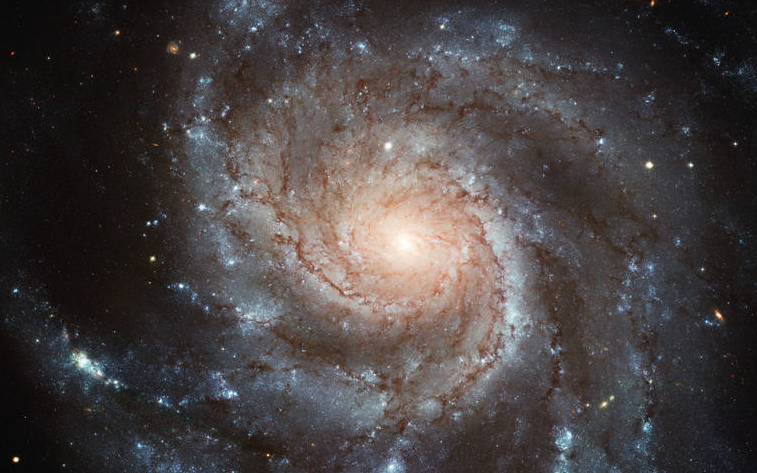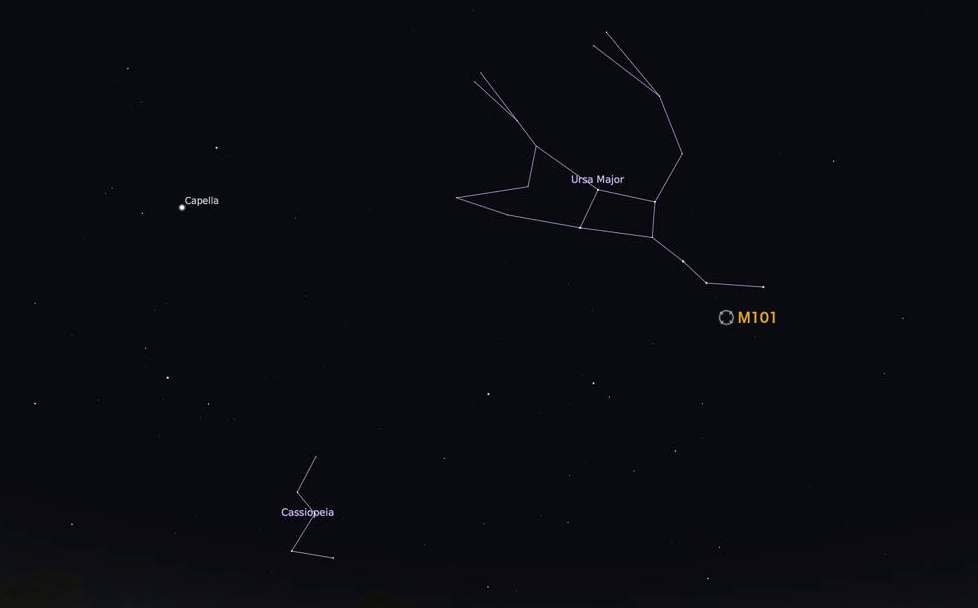Pinwheel Galaxy: The Amazing Astronomy Treasure
The Pinwheel Galaxy, Messier 101, in Ursa Major’s constellation, is visible through your telescope or high-powered binoculars. This star-filled giant bursts with color and density, so get ready for deep-sky excitement.
Table of Contents

What is the Pinwheel Galaxy?
This vast galaxy is almost twice the size of the Milky Way, with a large star formation nursery and clearly defined spiral arms. Its diameter stretches across 170,000 million light years, so it’s a massive target in night-sky-viewing. The Pinwheel Galaxy resides about 21 million light-years from Earth, but it’s still viewable from your (dark) backyard.
Initially given the designation NGC 5457 after its 1781 discovery by astronomer Pierre Méchain, the galaxy received the celestial item number 101 by Charles Messier.
M101 is also called the Pinwheel Galaxy because of its distinctive shape. It has colossal star-formation zones along its spiral arms, which scientists think is caused by gravitational interaction with nearby galaxies.
Where is the Pinwheel Galaxy Located?
Get out your binoculars to peer into the Ursa Major (Great Bear) Constellation. Then search for the bend in the Big Dipper’s handle. Next, locate the double stars, Alcor and Mizar, and now finally, shift your gaze approximately three and a half degrees east to see the Pinwheel Galaxy.
The image below is a compilation of infrared detectors aboard NASA’s Wide-field Infrared Survey Explorer (WISE.) In addition to seeing the Pinwheel Galaxy, two other galaxies are visible in the viewing field.
Look to the upper right to see the hazy purple patch of NGC 5477. This irregular dwarf galaxy is likely related to the Pinwheel.
Additionally, find the bright red spot towards the Pinwheel’s bottom. Then look to the right for a blue patch representing CG 272-018. It appears more faintly than M101 because it is about 92 million light years away from Earth. That means dinosaurs still roamed our lands when this light left its galaxy. It’s hard to wrap your mind around that!
In this small area of Ursa Major, you can observe three galaxies to make for dazzling deep-sky viewing.
What Type of Galaxy is the Pinwheel?
What’s the definition of a galaxy? According to NASA, “galaxies are vast cosmic islands of stars, gas, dust, and dark matter held together by gravity.” Essentially, they are the universe’s building blocks.
Three types of galaxies exist. They’re called spiral, elliptical, and irregular. They can be as small as containing a hundred million stars or as vast as having trillions of stars.
Spiral galaxies have yellowish bulges in the centers of their blue-white flat disc shapes. They form the most common type of galaxy in the universe, and accordingly, the Pinwheel Galaxy is an enormous spiral one.
Called a grand design spiral, M101 contains hundreds of billions of stars within its tightly wound prominent spiral arms. While some stars exist in its central bulge, they are thinly populated, causing the center’s transparent appearance.
Spiral Galaxies and Star Formation
Spiral galaxies act as star nurseries, continuously forming new stars. The Pinwheel Galaxy is no different. The colorful kaleidoscope of old and new stars shown below is a multi-spectral view of both aging and youthful stars on the galaxy’s well-defined spiral arms.
Stars are born in areas called HII (pronounced H-two) regions. Within these regions, the most giant-sized stars create ultraviolet radiation. Their stellar winds then create large holes or bubbles by eroding cosmic dust and gasses. Additionally, the radiation pulls electrons from neutral hydrogen gas (HI) to form clouds of ionized hydrogen (HII).
The Pinwheel Galaxy’s more than 3000 HII regions act as enormous stellar nurseries where some massive stars are born. As a result, more stars and dust appear in the spiral arms than in the Pinwheel Galaxy’s small, bulging center.
Compilation View of the Pinwheel Galaxy
This image collages data from x-ray, visible, ultraviolet, and infrared galaxy views. The compilation allows you to simultaneously see the galaxy from multiple viewpoints to observe new star formations alongside older stars.
The red and green colors represent infrared light from the Spitzer Space Telescope. They show green areas of hot cosmic dust lanes where stars form in the galaxy’s gas arms. The dense dust then gets warmed by the red heat of young star formations.
The yellow part of this image comes from the Hubble Telescope and represents visible light. It’s similar to what you’ll see with binoculars or a telescope. Most of this light glows from stars.
NASA’s Galaxy Evolution Explorer captured the hazy blue from young stars formed within the last million years, along with hundreds of millions of older, cooler stars. And then finally, the image shows the Pinwheel Galaxy’s hottest area.
Captured by the Chandra X-ray Observatory, the dark purples reflect x-ray emissions of million-degree gasses and exploding supernovas called shock fronts, which are similar to sonic booms. Additionally, the purples show space particles and rocks racing to collide into one another near black holes.
Is the Pinwheel Galaxy a Good Neighbor?
The Pinwheel Galaxy has six neighbors in its loose group of galaxies. Together they’re called the M101 group since it is their largest and most significant galaxy.
- NGC 5204
- NGC 5474
- NGC 5477
- NGC 5585
- UGC 8837
- UGC 9405
Because of its immense diameter, the Pinwheel Galaxy’s gravity interferes with its neighboring galaxies. Its gravitational influence may distort their shapes and compositions. While the stars won’t likely collide, the Pinwheel’s dust, gas, and magnetic fields do collide with their neighbors.
In addition, one side of M101 is asymmetrical. This phenomenon often occurs after a gravitational collision leading to the probability of neighboring influences.
Viewing the Pinwheel Galaxy
In the Northern hemisphere, the late winter and early spring months of March and April are the best time to view the Pinwheel Galaxy. That’s when the Ursa Major constellation is high in the night sky, where less light pollution exists.
Backyard binocular viewing of the Pinwheel Galaxy yields a hazy blue-and-white sight. While still a marvel to behold, the exciting colors seen in the images above come from NASA’s ability to compile spectra.
With a four-inch telescope, you can view the galaxy’s bright central core in a dark sky area. The spiral arms become more apparent with a six-inch or eight-inch telescope. (Unless you have a dedicated concrete platform, and storage options, a ten-inch telescope is too big for most hobbyists.)
Additionally, because of its orientation, you see the Pinwheel Galaxy face-on, so its namesake’s structure shines through. Quench part of your thirst for knowledge and curiosity about the universe by studying this astronomical beauty.

Conclusion
The Pinwheel Galaxy is a vast cosmic display located within the Ursa Major Constellation near the bend of the Big Dipper’s handle. This well-photographed galaxy combines the heat of stellar nurseries with the cool dust clouds in its arms to create billions of new stars.
Viewed from a dark-sky area, M101 lights up the night skies with its tightly wound spiral arms and pinwheel shape. So whether you are new to star-gazing or your enchantment goes back years, the Pinwheel Galaxy makes for exciting viewing.
